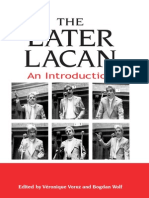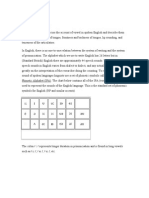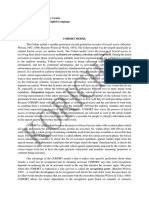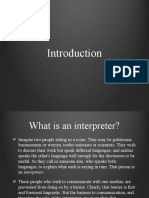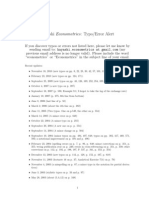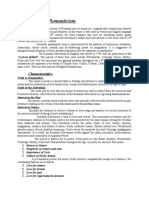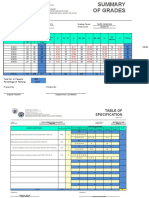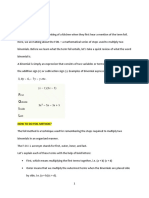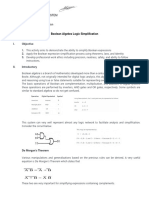0 ratings0% found this document useful (0 votes)
94 viewsAll About Consecutive Interpretation
All About Consecutive Interpretation
Uploaded by
jose maureThis document provides an overview of consecutive interpretation, including:
- A brief history of consecutive interpretation from ancient times to its use in modern international organizations.
- An explanation of how consecutive interpretation works, including note-taking techniques used by interpreters.
- Tips for speakers to help consecutive interpreters, such as briefing them in advance and establishing turn-taking routines.
- Qualities needed to be a successful consecutive interpreter, including language proficiency, analytical skills, and acting ability.
Copyright:
© All Rights Reserved
Available Formats
Download as DOCX, PDF, TXT or read online from Scribd
All About Consecutive Interpretation
All About Consecutive Interpretation
Uploaded by
jose maure0 ratings0% found this document useful (0 votes)
94 views9 pagesThis document provides an overview of consecutive interpretation, including:
- A brief history of consecutive interpretation from ancient times to its use in modern international organizations.
- An explanation of how consecutive interpretation works, including note-taking techniques used by interpreters.
- Tips for speakers to help consecutive interpreters, such as briefing them in advance and establishing turn-taking routines.
- Qualities needed to be a successful consecutive interpreter, including language proficiency, analytical skills, and acting ability.
Original Title
All about Consecutive Interpretation (1)
Copyright
© © All Rights Reserved
Available Formats
DOCX, PDF, TXT or read online from Scribd
Share this document
Did you find this document useful?
Is this content inappropriate?
This document provides an overview of consecutive interpretation, including:
- A brief history of consecutive interpretation from ancient times to its use in modern international organizations.
- An explanation of how consecutive interpretation works, including note-taking techniques used by interpreters.
- Tips for speakers to help consecutive interpreters, such as briefing them in advance and establishing turn-taking routines.
- Qualities needed to be a successful consecutive interpreter, including language proficiency, analytical skills, and acting ability.
Copyright:
© All Rights Reserved
Available Formats
Download as DOCX, PDF, TXT or read online from Scribd
Download as docx, pdf, or txt
0 ratings0% found this document useful (0 votes)
94 views9 pagesAll About Consecutive Interpretation
All About Consecutive Interpretation
Uploaded by
jose maureThis document provides an overview of consecutive interpretation, including:
- A brief history of consecutive interpretation from ancient times to its use in modern international organizations.
- An explanation of how consecutive interpretation works, including note-taking techniques used by interpreters.
- Tips for speakers to help consecutive interpreters, such as briefing them in advance and establishing turn-taking routines.
- Qualities needed to be a successful consecutive interpreter, including language proficiency, analytical skills, and acting ability.
Copyright:
© All Rights Reserved
Available Formats
Download as DOCX, PDF, TXT or read online from Scribd
Download as docx, pdf, or txt
You are on page 1of 9
All about Consecutive
Interpretation – FAQ
by InterStar Translations on in Best Practices, Business, Client Education, Conference
Interpreting, Conference Preparation, Consecutive Interpretation, Due Diligence, FAQ, how
to, Interpretation, Interpreter Education
A story about consecutive interpretation:
In the early days of conference consecutive interpretation there was a
genius interpreter, who could listen to a 2 hour speech and then deliver
his interpretation flawlessly. Instead of taking notes, he would take a
sheet of paper and start drawing the speaker’s portrait. Then, when it
was his time to interpret, he would “read” from the portrait, because
every line and notch associated with him mind with a speaker’s idea. At
the end of his interpretation, he would gift the portrait to the speaker!
What is consecutive interpretation?
In consecutive interpretation the interpreter repeats in the target
language the passage that the speaker has just said in the source
language. Strictly speaking, consecutive interpretation exists in two
configurations:
• long consecutive – the speaker can say not just one of two
sentences, but a passage or several passages. Students of
professional consecutive interpretation should be easily able to listen to
the original passage of up to 5 minutes and to deliver their
interpretation after that.
In some cases interpreters have been known to deliver 30 minute
passages. This mode of interpretation is better suited for official or
diplomatic occasions, when the speaker must have an opportunity to
deliver an entire speech and cannot be interrupted.
• short consecutive – usually only one or two sentences are said and
sometimes even a part of a sentence. This mode is more interactive
and requires faster turn-taking between the speaker and the
interpreter.
This mode is used more often and is better when the speaker wants to
establish rapport with the audience or when there is active interaction
between the speaker and the audience as in Q&A sessions, for
example, or lectures in front of live audience.
What situations are the most suitable for consecutive
interpretation?
Any situation you can imagine. Keep in mind, however, that
consecutive interpretation may take twice more time and plan your
speech accordingly. Consecutive interpretation is suitable for large
conferences, bilateral meetings, interviews, panel discussions and
business talks.
Nowadays, however, international
organizations such as the UN or the World Bank mostly
use simultaneous interpretation and leave consecutive for smaller or
bilingual meetings. It is understandable, because if there are more than
2 languages, consecutive interpretation may significantly delay
proceedings.
How consecutive interpretation evolved? What is its history?
Consecutive interpreter is a very old profession. Although we do not
have any records, a need for language interpretation probably first
arose when one prehistoric tribe wanted to communicate with another.
Interpretation becomes a profession already in the ancient world: first
professional interpreters are said to be present at the court of Egyptian
pharaohs, and the division between civilian and military interpreters
was already there in ancient Persia.
In Korea during the Joseon Kingdom (1392-1910) the jungin (or the
“middle people”) was a highly specialized group of technical experts
who helped aristocracy to run the government. There was a special
Office of Interpreters. The jungin taught civil servants foreign
languages and provided government interpreters for the court.
A Mayan vase depicts se veral
people being received by a ruler. Once of the shields says in classic
Mayan language: CHIJLAM or “interpreter.”
Throughout history many interpreters were also translators i.e. they
interpreted orally and worked as scribes who translated written texts as
required by their employers.
In Europe, Latin, French and English succeeded each other as the
language of diplomacy. Educated diplomats and statesmen were
usually multilingual and until the early XX century there was no
particular need for diplomatic interpreters as a separate category.
There was, however, a great need to communicate with inhabitants of
newly discovered lands, including the Americas. A few names of
interpreters survived, for example, Doña Marina or Malintzin helped
Cortés in at least three languages: Spanish, Náhuatl, and Chontal
Maya.
In the early XX century came the era of large international
conferences. Speeches could last for 2 hours and then the interpreter
for each language would take the floor and deliver the interpretation for
2 hours too – a very time consuming exercise.
With the invention of simultaneous interpretation the share of
consecutive gradually diminishes after WWII.
How is consecutive interpretation done?
It is obviously not possible to remember and recall 5 minutes of text:
human memory has very limited capacity and no special exercises may
lift certain biological limits and restrictions our memory has.
The interpreter analyzes the source text and uses special note
taking techniques to jot down the contents of the speech. Beginners
need to be warned, however, that the interpreter note-taking is not
stenography i.e. it does not put down on paper the text verbatim.
Writing down the entire text would
mean that the interpreter would be limited by the structure of the
original text rather than conveying its meaning. Each written sign or
word, however, should be the tip of an iceberg and activate in the
interpreter an entire chain of words or thoughts to be said.
Another common mistake beginners have is that they rely on their
notes too much. Your notes are only a reminder and the blueprint of
the entire passage should be kept safely in your head.
When the source text is listened to and analyzed, the interpreter is
taking notes and jots down the most important words, numbers, names
and connections between sentences and passages.
What is extremely important is to prioritize information and remember
about the message not just the words!
How are consecutive interpretation students trained?
Consecutive interpretation
students are run through a series of more and more difficult exercises
to analyze the source text, prioritize information and to deliver
interpretation.
It is much more than simply retelling in your own words: you should be
able to create in your target language the image of the speaker as if he
were speaking that language, but do it subtly, without mocking the
speaker and without attracting too much attention.
What qualities should I have to become a professional
consecutive interpreter?
Flawless command of your working languages, analytical skills, quick
thinking, ability to prioritize information quickly, and very importantly –
acting skills!
Consecutive interpreters are like actors on the live stage: your
presence, eye contact with the audience, voice skills are as important
as what you say.
What is more accurate: consecutive or simultaneous
interpretation?
This question was debated quite a
bit when simultaneous interpretation was being introduced in the
United Nations and other international organizations after WWII.
General consensus nowadays seems to be that professional language
interpreters who are well trained and are experienced can deliver very
high quality interpretation in both consecutive and simultaneous
modes. Simultaneous interpretation, however, seems to follow the
structure of the original more closely, while consecutive interpretation
gives more of a gist of the original speech.
How can I – as a speaker – best help my consecutive interpreter to
perform better?
Brief your interpreter on the topic
of your presentation and any important terminology. If you plan to tell
jokes, let your interpreter know: some jokes do not translate well.
Preparation is everything.
Agree in advance what length of passages you prefer in consecutive.
Usually one or several sentences will suffice. While professional
consecutive interpreters are able to translate rather long passages, you
do not want to tire your audience and it is best to make your
presentation more interactive, especially if it is educational in nature.
After the beginning of your presentation you and the interpreter will
establish a certain turn-taking routine and you will know in advance
how much time you have to think about the next passage while the
interpreter is speaking, and the interpreter will know the length of
passages you will give him or her. The rhythm will create the
atmosphere of predictability and will allow you to concentrate more on
the meaning of what you want to say and pay less attention to the fact
that you are being interpreted.
How to evaluate quality of consecutive interpretation?
Of course, without being a professional interpreter yourself (even if you
speak the languages) it is impossible to fully evaluate an interpreter’s
performance. There are way too many things a professional interpreter
has to keep in mind that a delegate may not even think about.
However, there are several clues
that may help you see if your interpreter does, indeed, deliver.
One of them is how much time the interpretation takes compared to the
original. Interpretation must never be more than 70%-80% of the
original in length: there is nothing worse than a substandard interpreter
droning on and on.
The reaction of the audience is also very important: do people nod their
heads, for example? A surefire way to see if you are understood is to
observe if the people in the audience blink – humans usually blink once
every several seconds and if delegates stare blankly into space when
the interpretation is being said then something may be wrong.
Make sure you get the reaction from the audience that you need: if
necessary, repeat but not in the same words: rephrasing helps both the
audience and the interpreter.
If the interpreter asks you a question or needs a clarification it is not at
all a sign of the interpreter’s weakness: professional interpreters must
be confident they understand the original fully and it is their duty to
clarify ambiguous passages.
You might also like
- Lecture 5. CoherenceDocument18 pagesLecture 5. Coherencekamilaabyl59No ratings yet
- The Later Lacan An IntroductionDocument296 pagesThe Later Lacan An Introductionmanfridweissmann100% (14)
- Vowels in Spoken EnglishDocument19 pagesVowels in Spoken Englishtulip07No ratings yet
- Reading 3 Day LessonDocument16 pagesReading 3 Day Lessonapi-370224084No ratings yet
- 10 Etymological Survey of The English WordDocument4 pages10 Etymological Survey of The English Wordsbikmm100% (1)
- A Course of Modern English Lexicology: Final Examination QuestionsDocument16 pagesA Course of Modern English Lexicology: Final Examination QuestionsAnna IspiryanNo ratings yet
- Jean-Paul Vinay and Jean Darbelnet: A Methodology For TranslationDocument23 pagesJean-Paul Vinay and Jean Darbelnet: A Methodology For TranslationMAYS Shaker100% (1)
- Introduction To Translation 1.1 What Is Translation?Document5 pagesIntroduction To Translation 1.1 What Is Translation?Desi KatrinaNo ratings yet
- English and Arabic Derivation For Translation StudentsDocument17 pagesEnglish and Arabic Derivation For Translation StudentsMuhammad El-Fiky100% (1)
- Introduction To Translation Chapter 2 SummaryDocument14 pagesIntroduction To Translation Chapter 2 Summaryxunus xNo ratings yet
- Glossary of Translation TermsDocument2 pagesGlossary of Translation Termsfreelancer800No ratings yet
- Lecture Types and Methods of TranslationDocument5 pagesLecture Types and Methods of Translationabdulfatah613No ratings yet
- SemanticsDocument23 pagesSemanticsJayson Donor Zabala100% (1)
- Group 8 - Assimilation & Elidion - EditedDocument61 pagesGroup 8 - Assimilation & Elidion - EditedDuyên BùiNo ratings yet
- Linguistics 22 23Document5 pagesLinguistics 22 23mustafa khalidNo ratings yet
- Indian English PresentationDocument16 pagesIndian English Presentationevelina_turcule4939No ratings yet
- What Is The Difference Between An Abbreviation and An AcronymDocument34 pagesWhat Is The Difference Between An Abbreviation and An AcronymPrincess Alexa RepalaNo ratings yet
- Assimilation of Borrowings. Types of Assimilation. Degree of Assimilation. Folk (False) EtymologyDocument1 pageAssimilation of Borrowings. Types of Assimilation. Degree of Assimilation. Folk (False) EtymologyМадина МурадиловаNo ratings yet
- The Nature of Listening SkillsDocument12 pagesThe Nature of Listening SkillsIlham IsmailNo ratings yet
- Linking in PhonologyDocument12 pagesLinking in PhonologyReemNo ratings yet
- Velarization - Mohammed MasoudDocument6 pagesVelarization - Mohammed MasoudMohammed MasoudNo ratings yet
- LinkingDocument8 pagesLinkingastri_idewNo ratings yet
- Difference Between Arabic and English in The Basic Sentence Structure Contrastive Analysis and Typical Translation ErrorsDocument5 pagesDifference Between Arabic and English in The Basic Sentence Structure Contrastive Analysis and Typical Translation ErrorsEditor IJTSRD100% (1)
- Test 1 English Ii AdvanceDocument3 pagesTest 1 English Ii AdvanceMartin Sepulveda Jara100% (1)
- Analyze The Characteristics of English Grammar During The Middle English Period.Document3 pagesAnalyze The Characteristics of English Grammar During The Middle English Period.KAKON AKTER RINKOU Fall 18100% (1)
- 4 Phonetics and Phonology: Key ConceptsDocument31 pages4 Phonetics and Phonology: Key ConceptsGaurav BharwanNo ratings yet
- تاشير أمتحان نهائيDocument30 pagesتاشير أمتحان نهائيanmar ahmedNo ratings yet
- Chapter 5 Summary ZKDocument1 pageChapter 5 Summary ZKZeynep KeskinNo ratings yet
- Teaching Listening: 1. BackgroundDocument13 pagesTeaching Listening: 1. BackgroundSigit Wahyu DantoNo ratings yet
- C + V Linking ExamplesDocument3 pagesC + V Linking ExamplesEslam El-HaddadNo ratings yet
- Linguistics Review - CDEDocument55 pagesLinguistics Review - CDEClau DuarteNo ratings yet
- Computer-Assisted Pronunciation Teaching (CAPT) To Overcome Pronunciation Difficulties Among EFL BeginnersDocument9 pagesComputer-Assisted Pronunciation Teaching (CAPT) To Overcome Pronunciation Difficulties Among EFL BeginnersInternational Journal of Innovative Science and Research TechnologyNo ratings yet
- Generative Phonology: Presented By: IRMA MAMING (2020203879102001) FADHILAH SANTRI (2020203879102002)Document9 pagesGenerative Phonology: Presented By: IRMA MAMING (2020203879102001) FADHILAH SANTRI (2020203879102002)fadhilah santriNo ratings yet
- Development of A Mobile App For Language LearningDocument11 pagesDevelopment of A Mobile App For Language Learningsasusmc7No ratings yet
- Comment On The Basic Approaches To Translation and InterpretationDocument4 pagesComment On The Basic Approaches To Translation and InterpretationИлона Киреева50% (2)
- PhonologyDocument13 pagesPhonologyMa Anne QuitorianoNo ratings yet
- Chapter 01 Sounds Spelling and SymbolsDocument3 pagesChapter 01 Sounds Spelling and SymbolsAbdurrahman Shaleh Reliubun60% (5)
- Stylistics - Lesson 1 PDFDocument13 pagesStylistics - Lesson 1 PDFCherry Mae J. GapatanNo ratings yet
- Lexicology Course Description BujaDocument2 pagesLexicology Course Description BujaIoana Alexandra100% (1)
- Chapter 15 Gestures and Sign Languages: The Study of Language, 5 Edition George YuleDocument8 pagesChapter 15 Gestures and Sign Languages: The Study of Language, 5 Edition George Yulesovanrat KhievNo ratings yet
- Teaching PronunciationDocument6 pagesTeaching Pronunciationapi-268185812100% (1)
- 0 - de Thi Syntax - VB2 - 2021Document2 pages0 - de Thi Syntax - VB2 - 2021Kha HoàngNo ratings yet
- First and Second Language AcquisitionDocument3 pagesFirst and Second Language AcquisitionHeny AmbarwatiNo ratings yet
- Sound Assimilation in English and Arabic A Contrastive Study PDFDocument12 pagesSound Assimilation in English and Arabic A Contrastive Study PDFTaha TmaNo ratings yet
- (Psycholinguistics) Cohort Model PDFDocument5 pages(Psycholinguistics) Cohort Model PDFYasser HaddouNo ratings yet
- Eliciting Vocabulary and Checking UnderstandingDocument1 pageEliciting Vocabulary and Checking UnderstandingThuy (AEKT-AMES-HVT) Dang ThiNo ratings yet
- Theoretical Phonetics PPT 08.09.2021Document21 pagesTheoretical Phonetics PPT 08.09.2021BagzhanNo ratings yet
- English LexicologyDocument61 pagesEnglish Lexicologymari100% (2)
- Introduction To English LinguisticsDocument8 pagesIntroduction To English LinguisticsLee Ayn PoncardasNo ratings yet
- Chapter 5 - Reading and TranslationDocument41 pagesChapter 5 - Reading and TranslationTuyenLe100% (1)
- Xbar Theory Vs Traditional Grammar and Structural GrammarDocument2 pagesXbar Theory Vs Traditional Grammar and Structural GrammarlilydevilNo ratings yet
- Applied Linguistics (AL)Document18 pagesApplied Linguistics (AL)nettach ikramNo ratings yet
- Ellt Methods and ApproachesDocument53 pagesEllt Methods and ApproachesFabian TorresNo ratings yet
- An Introduction To Translation Studies SB PDFDocument101 pagesAn Introduction To Translation Studies SB PDFLam UyênNo ratings yet
- Assessing SpeakingDocument36 pagesAssessing SpeakingOni setiawan ParanginanginNo ratings yet
- SLA Question Bank Chapters 1Document43 pagesSLA Question Bank Chapters 1Ghulam SabirNo ratings yet
- Speaking by Martin BygateDocument16 pagesSpeaking by Martin BygateRoyhan Malik PulunganNo ratings yet
- LP - Gradable and Non-Gradable Adjectives 11.13.14 - Alexandra Van Den HeeverDocument5 pagesLP - Gradable and Non-Gradable Adjectives 11.13.14 - Alexandra Van Den HeeverMARCELANo ratings yet
- Subfields of Applied LinguisticsDocument29 pagesSubfields of Applied LinguisticsLaarni Airalyn CabreraNo ratings yet
- Contrastive WEEK 3Document11 pagesContrastive WEEK 3Nguyễn Anh DuyNo ratings yet
- Lesson 1Document24 pagesLesson 1Juan Carlos Solís RiveraNo ratings yet
- What Does An Interpreter DoDocument2 pagesWhat Does An Interpreter DoMartinNo ratings yet
- Q4M1 - MAPEH08 - SY23-24 (Edited)Document13 pagesQ4M1 - MAPEH08 - SY23-24 (Edited)christianlyletorresNo ratings yet
- 1997 Essay 1Document2 pages1997 Essay 1api-267639414No ratings yet
- Hayashi Econometrics: Typo/Error AlertDocument11 pagesHayashi Econometrics: Typo/Error AlertKyle TsengNo ratings yet
- BM W1Document7 pagesBM W1Glaiza Dalayoan FloresNo ratings yet
- 香港學前中文教育研究 幼兒語文教與學現況調查Document6 pages香港學前中文教育研究 幼兒語文教與學現況調查TtNo ratings yet
- 3.elemntary Programing Part 1Document26 pages3.elemntary Programing Part 1youssefNo ratings yet
- Local Storage Data: Android Development With Kotlin v1.0Document28 pagesLocal Storage Data: Android Development With Kotlin v1.0Adhystira Raihannoeza AlmadivaNo ratings yet
- Lab MenualDocument206 pagesLab MenualMohammed Abdul Kader Sabuj0% (1)
- Powerpoint (Unit-6)Document8 pagesPowerpoint (Unit-6)Kamal MittalNo ratings yet
- Edward Locke Resume 2023Document3 pagesEdward Locke Resume 2023api-254585414No ratings yet
- HP Designjet Printers - Cleaning The Encoder StripDocument5 pagesHP Designjet Printers - Cleaning The Encoder Stripttrack7No ratings yet
- Best Camping Ever GarcDocument4 pagesBest Camping Ever GarcAlice CabanaNo ratings yet
- ThinkPad L380 Platform SpecificationsDocument1 pageThinkPad L380 Platform Specificationspesov69749No ratings yet
- Romantics and Romanticism: CharacteristicsDocument4 pagesRomantics and Romanticism: CharacteristicsNoor UlainNo ratings yet
- Illness - A Christian ReflectionDocument3 pagesIllness - A Christian Reflectionpilea7No ratings yet
- Project-Proposal of Anis - AhmmedDocument2 pagesProject-Proposal of Anis - AhmmedMir JavedNo ratings yet
- Diode Resistance..Document18 pagesDiode Resistance..GAMES TECHNo ratings yet
- L2 TranslationDocument4 pagesL2 Translationyasser.bouzana5No ratings yet
- 40 Studies - Ekman and FriesenDocument6 pages40 Studies - Ekman and FriesenRith PadNo ratings yet
- English: Quarter 1 - Module 3: Active and Passive Voices VoicesDocument15 pagesEnglish: Quarter 1 - Module 3: Active and Passive Voices VoicesDionne Sebastian Doromal100% (4)
- Template Tosia 2022 2023Document8 pagesTemplate Tosia 2022 2023Hanz paul IguironNo ratings yet
- Southeast Asia What S in A Name by Donald K EmmersonDocument22 pagesSoutheast Asia What S in A Name by Donald K EmmersonFrançoisDeLaBellevieNo ratings yet
- AIT Solved PaperDocument65 pagesAIT Solved PaperAjay KadamNo ratings yet
- DataStage Connectivity Guide For ODBCDocument106 pagesDataStage Connectivity Guide For ODBCmohenishjaiswal100% (1)
- Foil MethodDocument6 pagesFoil MethodPaula FanaNo ratings yet
- Final CoverageDocument20 pagesFinal CoverageRica LangresNo ratings yet
- Vinayatexts01davi PDFDocument452 pagesVinayatexts01davi PDFemsi_homeNo ratings yet
- Mendoza - Experiment No.9Document3 pagesMendoza - Experiment No.9Aldrin MndzNo ratings yet

